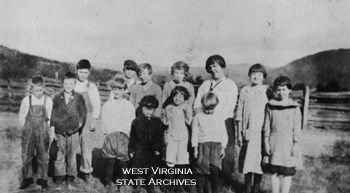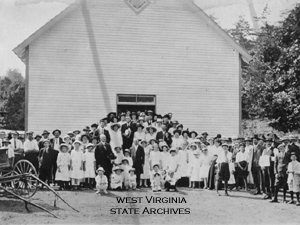
Brief History
Of Early Times
In Lost River Community
by F. B. Chrisman1925

 |
The first permanent settlement in this community was made about
the year 1750.
The grants to the first settlers bear dates from 1748 to 1755. The grants were surveyed by George Washington in 1748 (when he was sixteen years old) for Lord Fairfax who had received a grant from the King of England for all of the northern |
Captain Jacob Chrisman, born in 1730, (whose mother was a daughter of Joist Hite who came fron York, Pennsylvania in the year 1732 and settled about five miles south of Winchester, Virginia) with several other men followed a band of Indians who had killed some settlers of the Shenandoah Valley and taken some prisoners across the North Mountain, arriving at Rock Bridge now the state boundary on North Mountain after dark. Captain Chrisman sighted the Indian's camp fire near the top of Branch Mountain and came to their camp just before dawn. He surprised the and after killing three of their number and recovering the prisoners, returned to this valley and decided to take a lease which he did in 1753. The patent calls for a tract of 425 acres of land on Lost River of Cacapon, patented to Jacob Chrisman, Jr., by Lord Fairfax, September 15, 1753.
Lionel Branson, an English Quaker, settled on Lost River in 1765 and is reputed to have cut the first wagon road following the old Indian Trail across Rock Bridge from the Shenandoah to this valley. The Millers, Claypools, Wardens, and Bakers settled here about the same date.
Tradition has it Indians often made trouble for the early settlers of our little valley. One story is told of two men being surprised while watching a deer lick. One man had climbed a tree, his dog having followed his track and laid at the foot of the tree. When seven Indians came to the spring for water the dog barked which caused the Indians to look up into the tree. They killed and scalped this man while his companion sitting in another tree afraid to shoot at so many enemies escaped.
A family named Elswicks living near the old Indian Trail that crossed the valley on the lands now owned by the Harpers were surprised by Indians who captured all the women and children while the men were away from home. Several women and one child were killed while one little girl was carried away. When she grew up she married an Indian and brought him back to her old home. One day he went hunting with her brothers on the Little Ridge, but never returned.
The only fort in this vicinity was a small block house near the river on the line between the Chrisman and Wood farms. The larger forts on Lost River were Ruddle's Fort on the old Inskeep place where a man named Chesmer was killed and Warden's Fort where Wm. Warden the ancestor of the present owner Wm. H. Warden and a Mr. Taff were killed and the fort burned.
| The Wardens who settled on the farm now owned by Wm. H. Warden were Presbyterians; the Millers and Bakers (the latter family being the first permanent settlers at Baker) were Baptists. Anthony Miller, a Baptist, deeded one acre of land, probably about 1835, jointly to the Baptists and Presbyterians as a site for the first church in the Lost River Valley. The people of the community built the log church which is still standing and is now used by the Union Tanning Company for a store room. |  |
Along in the early part of 1800 Lionel Branson and Jeremiah Inskeep each built brick houses the latter of which is still being used as a residence. In 1808 Squire Jacob Miller built a brick house which is still in a good state of preservation and is now owned and used as a residence by Chas. A. Garrett. The oldest log house, a part of which is still standing is the old Claypoole house on the lands now owned by John Moyers. This farm was settled by John Claypoole, a son of James Claypoole, an English Quaker who was born February 14th, 1701, and settled in what is now Rockingham County, Virginia. John Claypoole was born in 1732, was married twice, and was the father of twenty-two children.
The first grist mill in the valley was built by Lionel Branson on the lands now owned by the Union Tanning Company. The first tan yard was on Still Run where the remains of the old tan vats can still be seen. By the process then used it took one year to tan a hide. The present steam tannery at Lost City was built by Thomas Cover about 1892.